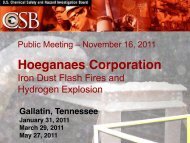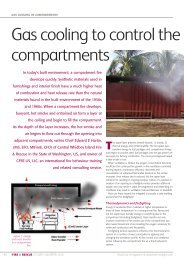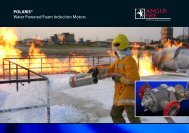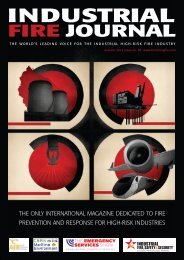New Perspectives on the Critical Velocity for Smoke Control
New Perspectives on the Critical Velocity for Smoke Control
New Perspectives on the Critical Velocity for Smoke Control
Create successful ePaper yourself
Turn your PDF publications into a flip-book with our unique Google optimized e-Paper software.
Fourth Internati<strong>on</strong>al Symposium <strong>on</strong> Tunnel Safety and Security, Frankfurt am Main, Germany, March 17-19, 2010<br />
<str<strong>on</strong>g>New</str<strong>on</strong>g> <str<strong>on</strong>g>Perspectives</str<strong>on</strong>g> <strong>on</strong> <strong>the</strong> <strong>Critical</strong> <strong>Velocity</strong> <strong>for</strong> <strong>Smoke</strong><br />
C<strong>on</strong>trol<br />
Fathi Tarada<br />
Mosen Ltd<br />
Crawley, West Sussex<br />
United Kingdom<br />
fathi.tarada@mosenltd.com<br />
ABSTRACT<br />
This paper presents new analytical soluti<strong>on</strong>s <strong>for</strong> <strong>the</strong> critical velocity <strong>for</strong> smoke c<strong>on</strong>trol in tunnels and<br />
cross-passages. These analytical soluti<strong>on</strong>s <strong>for</strong> <strong>the</strong> critical velocity dispense with <strong>the</strong> need to solve <strong>for</strong><br />
two coupled n<strong>on</strong>-linear equati<strong>on</strong>s, and avoid <strong>the</strong> drawbacks associated with iterative approaches to<br />
solving <strong>for</strong> such equati<strong>on</strong>s. The paper also discusses <strong>the</strong> use of <strong>the</strong> critical velocity c<strong>on</strong>cept in road,<br />
rail and metro tunnels, both as a design objective and also as a target <strong>for</strong> emergency operati<strong>on</strong>s. It<br />
c<strong>on</strong>cludes that <strong>the</strong>re are significant drawbacks in <strong>the</strong> generati<strong>on</strong> of tunnel air velocities in excess of<br />
<strong>the</strong> critical velocity, due to <strong>the</strong> increased risks of fire growth and <strong>the</strong> destructi<strong>on</strong> of any smoke<br />
stratificati<strong>on</strong>. The importance of tunnel ventilati<strong>on</strong> c<strong>on</strong>trol in emergency scenarios is <strong>the</strong>re<strong>for</strong>e<br />
emphasised.<br />
KEYWORDS: critical velocity, smoke, fire, tunnel<br />
INTRODUCTION<br />
Thomas [1] was <strong>the</strong> first to propose a simple relati<strong>on</strong>ship to determine <strong>the</strong> critical velocity needed to<br />
prevent <strong>the</strong> upstream movement of smoke from fire in a tunnel. He argued that <strong>the</strong> flow character<br />
depended, in essence, <strong>on</strong> <strong>the</strong> ratio of buoyancy to inertial <strong>for</strong>ces over a cross-secti<strong>on</strong> of <strong>the</strong> tunnel, and<br />
that this ratio could be described by a parameter having <strong>the</strong> <strong>for</strong>m of a Froude number, Fr m :<br />
) (1)<br />
where g is accelerati<strong>on</strong> due to gravity, H is tunnel height, ∆θ is <strong>the</strong> temperature rise above ambient, U<br />
is ventilati<strong>on</strong> velocity and T is <strong>the</strong> hot layer temperature. Thomas assumed that <strong>the</strong> critical c<strong>on</strong>diti<strong>on</strong>,<br />
when back-flow is just suppressed, occurs when Fr m is of order unity, that is when <strong>the</strong> inertial and<br />
buoyancy <strong>for</strong>ces are similar.<br />
According to <strong>the</strong> experimental measurements of Lee et al [2], Froude numbers of less than 4.5 are<br />
required to preclude <strong>the</strong> movement of smoke against <strong>the</strong> imposed ventilati<strong>on</strong> flow directi<strong>on</strong>.<br />
By relating <strong>the</strong> temperature rise of <strong>the</strong> hot gases from a fire (Δθ) to <strong>the</strong> c<strong>on</strong>vective heat release rate<br />
from <strong>the</strong> fire Q ) , Kennedy [3] proposed a <strong>for</strong>mula <strong>for</strong> <strong>the</strong> critical velocity, such:<br />
(<br />
c<br />
V<br />
c<br />
⎛<br />
⎜<br />
gHQ<br />
c<br />
=<br />
⎝ ρC<br />
p<br />
ATf<br />
Fr<br />
m<br />
⎞<br />
⎟<br />
⎠<br />
1/ 3<br />
(2)<br />
where <strong>the</strong> critical Froude number (Fr m ) is given by<br />
419
Fourth Internati<strong>on</strong>al Symposium <strong>on</strong> Tunnel Safety and Security, Frankfurt am Main, Germany, March 17-19, 2010<br />
Fr m<br />
= 4.5(1 + 0.0374 min( grade,0)<br />
0.8 −3<br />
)<br />
(3)<br />
and<br />
grade = gradient of <strong>the</strong> tunnel in percent<br />
A = cross-secti<strong>on</strong>al area of tunnel (m 2 )<br />
ρ = density of upstream air (kg/m 3 )<br />
and <strong>the</strong> hot-gas temperatureT f<br />
is estimated from <strong>the</strong> enthalpy c<strong>on</strong>servati<strong>on</strong> equati<strong>on</strong>:<br />
Q (4)<br />
c<br />
Tf = + T ρ C AV<br />
p<br />
Equati<strong>on</strong>s (2) and (4) <strong>for</strong>m a coupled set that are solved within many well-used tunnel ventilati<strong>on</strong><br />
programmes including <strong>the</strong> Subway Envir<strong>on</strong>mental Simulati<strong>on</strong> (SES) Computer Programme [4].<br />
N<strong>on</strong>e<strong>the</strong>less, Grant et al [5] have pointed out several methodological weaknesses in this model,<br />
including its failure to account <strong>for</strong> <strong>the</strong> complex near-fire flow field and <strong>the</strong> interacti<strong>on</strong> between <strong>the</strong><br />
fire source and <strong>the</strong> particular tunnel under c<strong>on</strong>siderati<strong>on</strong>.<br />
By analogy to <strong>the</strong> results <strong>for</strong> tunnels, Tarada [6] extended <strong>the</strong> model based <strong>on</strong> a critical Froude<br />
number approach to <strong>the</strong> calculati<strong>on</strong> of <strong>the</strong> critical velocity within cross-passages. He proposed <strong>the</strong><br />
simultaneous soluti<strong>on</strong> of <strong>the</strong> enthalpy equati<strong>on</strong> <strong>for</strong> <strong>the</strong> juncti<strong>on</strong> between <strong>the</strong> tunnel and cross-passage:<br />
p<br />
T<br />
p<br />
d<br />
c<br />
( m C T ) + ( mC T ) + Q<br />
= ( mC T )<br />
(5)<br />
c<br />
p<br />
f<br />
T<br />
(where <strong>the</strong> subscript ‘T’ refers to <strong>the</strong> main tunnel, ‘d’ refers to <strong>the</strong> cross-passage door and ‘f’ refers to<br />
<strong>the</strong> hot-gas c<strong>on</strong>diti<strong>on</strong>s), with <strong>the</strong> equati<strong>on</strong> <strong>for</strong> <strong>the</strong> critical Froude number at <strong>the</strong> cross-passage door,<br />
which is written as:<br />
Fr<br />
m<br />
gH ρ (6)<br />
= grade<br />
d<br />
( − ρ<br />
f<br />
)<br />
0.8 −3<br />
= 4.5(1 + 0.0374 min( ,0) )<br />
2<br />
ρVd<br />
One drawback of using <strong>the</strong> coupled n<strong>on</strong>-linear equati<strong>on</strong>s (2&4) and (5&6) is that to date, no direct or<br />
analytical soluti<strong>on</strong>s were available. Ra<strong>the</strong>r, iterative approaches to solving <strong>the</strong> equati<strong>on</strong>s were<br />
employed. These have a number of drawbacks, including <strong>the</strong> need to provide a reas<strong>on</strong>able initial<br />
guess <strong>for</strong> <strong>the</strong> critical velocity, <strong>the</strong> complicati<strong>on</strong>s relating to programming <strong>the</strong> iterative soluti<strong>on</strong><br />
process, and residual errors due to incomplete c<strong>on</strong>vergence of <strong>the</strong> iterative soluti<strong>on</strong>. These issues will<br />
be resolved through <strong>the</strong> provisi<strong>on</strong> of analytical soluti<strong>on</strong>s to <strong>the</strong> critical velocities in tunnels and crosspassages<br />
in this paper.<br />
ANALYTICAL SOLUTIONS<br />
<strong>Critical</strong> Air Velocities <strong>for</strong> Tunnels<br />
It is possible to recast equati<strong>on</strong>s (2) and (4) into <strong>the</strong> following single equati<strong>on</strong>:<br />
( ) V c<br />
3<br />
Fr m ⋅A⋅C p ⋅T⋅ρ<br />
⋅<br />
( ) V c<br />
2<br />
+ Fr m ⋅Q c ⋅ ⋅−g⋅H⋅Q c 0<br />
(7)<br />
This represents a cubic equati<strong>on</strong> <strong>for</strong> <strong>the</strong> critical velocity V c , with up to three distinct soluti<strong>on</strong>s (roots).<br />
For a general cubic equati<strong>on</strong> in <strong>the</strong> <strong>for</strong>m<br />
420
Fourth Internati<strong>on</strong>al Symposium <strong>on</strong> Tunnel Safety and Security, Frankfurt am Main, Germany, March 17-19, 2010<br />
3 2<br />
Ax + Bx + Cx + D = 0<br />
(8)<br />
<strong>the</strong> nature of <strong>the</strong> three roots will depend <strong>on</strong> <strong>the</strong> value of <strong>the</strong> discriminant Δ [7]:<br />
3 2 2<br />
3 2 2<br />
∆ = 18ABCD<br />
− 4B<br />
D + B C − 4AC<br />
− 27A<br />
D<br />
(9)<br />
The following cases need to be c<strong>on</strong>sidered:<br />
• If Δ > 0, <strong>the</strong>n <strong>the</strong> equati<strong>on</strong> has three distinct real roots.<br />
• If Δ = 0, <strong>the</strong>n <strong>the</strong> equati<strong>on</strong> has a multiple root and all its roots are real.<br />
• If Δ < 0, <strong>the</strong>n <strong>the</strong> equati<strong>on</strong> has <strong>on</strong>e real root and two n<strong>on</strong>real complex c<strong>on</strong>jugate roots.<br />
From equati<strong>on</strong> (7), <strong>the</strong> linear coefficient C=0, hence <strong>the</strong> discriminant Δ < 0, as l<strong>on</strong>g as<br />
Q<br />
c<br />
ρAC<br />
<<br />
2<br />
p<br />
T<br />
27gH<br />
Fr<br />
m<br />
(10)<br />
For a road tunnel with <strong>the</strong> following parameters:<br />
A=80 m 2 , T=300 K, C p =1040 J/(kgK), ρ=1.1 kg/m 3 , H=6m, grade=0%<br />
it can be seen that equati<strong>on</strong> (10) implies that <strong>the</strong> discriminant Δ
Fourth Internati<strong>on</strong>al Symposium <strong>on</strong> Tunnel Safety and Security, Frankfurt am Main, Germany, March 17-19, 2010<br />
Equati<strong>on</strong> (11) is <strong>the</strong> analytical soluti<strong>on</strong> <strong>for</strong> <strong>the</strong> critical velocity <strong>for</strong> smoke c<strong>on</strong>trol in a tunnel. In order<br />
to check <strong>the</strong> feasibility of <strong>the</strong> soluti<strong>on</strong>s, comparis<strong>on</strong>s were undertaken between <strong>the</strong> values provided by<br />
equati<strong>on</strong> (11) and those generated through <strong>the</strong> coupled soluti<strong>on</strong>s of equati<strong>on</strong>s (2) and (4). Using <strong>the</strong><br />
road tunnel example provided above with Q c =30×10 6 W, we arrive at V c =2.112 m/s using equati<strong>on</strong><br />
(11), and <strong>the</strong> same result within three decimal places using four iterati<strong>on</strong>s of equati<strong>on</strong>s (2) and (4).<br />
<strong>Critical</strong> Air Velocities <strong>for</strong> Cross-Passages<br />
Fire<br />
Main tunnel<br />
L<strong>on</strong>gitudinal air flow<br />
<strong>Smoke</strong><br />
Cross-passage<br />
Fig. 1: C<strong>on</strong>trol Volume <strong>for</strong> <strong>the</strong> Enthalpy Balance in a Tunnel Cross-Passage<br />
A similar analytical soluti<strong>on</strong> can be inferred <strong>for</strong> <strong>the</strong> critical velocity in cross-passages. The enthalpy<br />
balance from equati<strong>on</strong> (5) can be rewritten as<br />
ρ A V C T + ρA V C T + Q = ( ρA V + ρA V ) C T<br />
(13)<br />
T<br />
T<br />
p<br />
d<br />
d<br />
p<br />
Cross-flow<br />
c<br />
T<br />
T<br />
d<br />
d<br />
p<br />
f<br />
Substituting equati<strong>on</strong> (6) into equati<strong>on</strong> (13), <strong>the</strong> following cubic equati<strong>on</strong> can be derived <strong>for</strong> <strong>the</strong><br />
critical velocity through a cross-passage door (V d ):<br />
3<br />
2<br />
{ Fr C A T} V { Fr [ Q + ρA V C T ]} V − gH Q = 0<br />
m<br />
p<br />
d<br />
d<br />
+<br />
m c T T p d d c<br />
ρ (14)<br />
By reference to <strong>the</strong> analytical soluti<strong>on</strong>s <strong>for</strong> a cubic equati<strong>on</strong> with Δ
Fourth Internati<strong>on</strong>al Symposium <strong>on</strong> Tunnel Safety and Security, Frankfurt am Main, Germany, March 17-19, 2010<br />
Q<br />
a =<br />
c<br />
gH<br />
dQc<br />
c = −<br />
Fr ρC<br />
A T<br />
2<br />
ˆ a<br />
Q = −<br />
9<br />
ˆ − 27c<br />
− 2a<br />
R =<br />
54<br />
Sˆ<br />
= ⎜ R<br />
⎝<br />
Tˆ<br />
= ⎜ R<br />
⎝<br />
+ ρ A V C T<br />
(16)<br />
ρC<br />
m<br />
p<br />
T<br />
3<br />
⎛ ˆ ˆ 3<br />
+ +<br />
Q<br />
⎛ ˆ ˆ 3<br />
− +<br />
Q<br />
A T<br />
p<br />
d<br />
Equati<strong>on</strong> (15) is <strong>the</strong> analytical soluti<strong>on</strong> <strong>for</strong> <strong>the</strong> critical velocity <strong>for</strong> smoke c<strong>on</strong>trol through a crosspassage.<br />
In order to check <strong>the</strong> feasibility of <strong>the</strong> soluti<strong>on</strong>s, comparis<strong>on</strong>s were undertaken between <strong>the</strong><br />
values provided by equati<strong>on</strong> (15) and those generated through <strong>the</strong> coupled soluti<strong>on</strong>s of equati<strong>on</strong>s (6)<br />
and (13). Using <strong>the</strong> road tunnel example provided above with A d =4.4m 2 , H d =2.2m and V T =2m/s, we<br />
arrive at V d =1.287 m/s using equati<strong>on</strong> (16), and <strong>the</strong> same result within three decimal places using two<br />
iterati<strong>on</strong>s of equati<strong>on</strong>s (6) and (13).<br />
APPLICATION TO TUNNEL VENTILATION DESIGN<br />
The estimati<strong>on</strong> of <strong>the</strong> critical velocity <strong>for</strong> smoke c<strong>on</strong>trol is <strong>on</strong>ly a small comp<strong>on</strong>ent in <strong>the</strong> process of<br />
tunnel ventilati<strong>on</strong> design. The main steps in defining <strong>the</strong> required ventilati<strong>on</strong> capacity <strong>for</strong> smoke<br />
c<strong>on</strong>trol in a tunnel<br />
1. Define design fire, including incident vehicle type(s) and heat release rates<br />
2. Define operati<strong>on</strong>al scenarios, including vehicular traffic and wind c<strong>on</strong>diti<strong>on</strong>s<br />
3. Establish <strong>the</strong> required air velocities <strong>for</strong> smoke c<strong>on</strong>trol<br />
4. Calculate ‘hot case’ c<strong>on</strong>diti<strong>on</strong>s (with fire, adverse wind, open cross-passage doors and with no fan<br />
redundancy)<br />
5. Calculate ‘cold case’ c<strong>on</strong>diti<strong>on</strong>s (without fire, favourable wind, closed cross-passage doors and<br />
with full fan redundancy)<br />
While <strong>the</strong> purpose of step (4) is to ensure that sufficient ventilati<strong>on</strong> capacity has been designed to<br />
c<strong>on</strong>trol smoke movement, step (5) is required to ensure that <strong>the</strong> tunnel air velocity does not exceed<br />
11m/s during its envisaged operati<strong>on</strong> (as per NFPA 130 [9] and NFPA 502 [10], <strong>for</strong> example). This is<br />
particularly critical <strong>for</strong> tunnel ventilati<strong>on</strong> systems that are installed without any feedback systems to<br />
c<strong>on</strong>trol <strong>the</strong> tunnel air velocity during an incident.<br />
THE CASE FOR TUNNEL VENTILATION CONTROL<br />
Most tunnel ventilati<strong>on</strong> systems designed to recent standards have significant levels of redundancy,<br />
and are capable of c<strong>on</strong>trolling smoke movement even during very adverse circumstances (adverse<br />
wind, open cross-passage doors, fans damaged due to proximity to fire). As an example of <strong>the</strong> level of<br />
jetfan redundancy required, <strong>the</strong> UK’s Design Manual <strong>for</strong> Roads and Bridges BD78/99 recommends<br />
that <strong>the</strong> greater of two jetfans or 10% of <strong>the</strong> jetfans (to <strong>the</strong> next whole fan number) should be<br />
c<strong>on</strong>sidered to be out of service, and a number of jetfans should be c<strong>on</strong>sidered destroyed due to <strong>the</strong><br />
fire, in accordance with Table 1. However, it is possible that during <strong>the</strong> initial stages of a fire, all <strong>the</strong><br />
jetfans may actually be available, leading to a significant oversupply of fan capacity.<br />
T<br />
d<br />
p<br />
Rˆ<br />
Rˆ<br />
2<br />
2<br />
⎟<br />
⎞<br />
⎠<br />
⎟<br />
⎞<br />
⎠<br />
1/ 3<br />
1/ 3<br />
423
Fourth Internati<strong>on</strong>al Symposium <strong>on</strong> Tunnel Safety and Security, Frankfurt am Main, Germany, March 17-19, 2010<br />
Fire Size (MW) Distance Upstream of Fire (m) Distance Downstream of Fire (m)<br />
5 - -<br />
20 10 40<br />
50 20 80<br />
100 30 120<br />
Table 1: Distances over which Jet Fans may be c<strong>on</strong>sidered as destroyed during Fire [12]<br />
It is certainly possible that a tunnel ventilati<strong>on</strong> system may ‘blow too hard’ and actually increase <strong>the</strong><br />
fire heat release rate from a burning vehicle. Fig. 2 depicts <strong>the</strong> possible enhancement factors ‘k’ of<br />
peak fire heat release rates from burning heavy goods vehicles (HGVs), as a functi<strong>on</strong> of tunnel<br />
ventilati<strong>on</strong> velocity. Values of ‘k’ above unity indicate an enhancement in <strong>the</strong> fire heat release rate.<br />
The two curves shown are <strong>for</strong> single-lane and dual-lane tunnels The exact physical processes involved<br />
in <strong>the</strong> fire heat release rate enhancement are not well understood, but could involve providing<br />
additi<strong>on</strong>al oxygen to partially shielded fires within a burning HGV. Apart from enhancing <strong>the</strong> peak<br />
fire heat release rate, <strong>the</strong>re is also <strong>the</strong> possibility of a higher fire growth rate within <strong>the</strong> burning<br />
vehicle, and of fire spread to o<strong>the</strong>r vehicles within <strong>the</strong> tunnel.<br />
Fig. 2: Fire Heat Release Rate Enhancement Factors (after Carvel et al [11])<br />
In order to avoid <strong>the</strong> drawbacks of excessive air velocities and possible fire enhancement, a c<strong>on</strong>trol<br />
system may be required to m<strong>on</strong>itor <strong>the</strong> tunnel air velocities and feed <strong>the</strong>se air velocities back to an<br />
automatic c<strong>on</strong>trol system. Such a ventilati<strong>on</strong> c<strong>on</strong>trol system is c<strong>on</strong>sidered standard in a number of<br />
European countries including Switzerland and Austria, but not in <strong>the</strong> United Kingdom, <strong>for</strong> example.<br />
The Austrian design standard RVS 09.02.31 [13] specifies that <strong>the</strong> l<strong>on</strong>gitudinal ventilati<strong>on</strong> system<br />
should reduce <strong>the</strong> air velocity in unidirecti<strong>on</strong>al traffic to between 1.5 m/s to 2 m/s, and <strong>for</strong><br />
bidirecti<strong>on</strong>al traffic to a value between 1 m/s and 1.5 m/s. The Austrian design standard does not<br />
however menti<strong>on</strong> any requirement to meet <strong>the</strong> critical air velocity <strong>for</strong> smoke c<strong>on</strong>trol.<br />
For unidirecti<strong>on</strong>al traffic without c<strong>on</strong>gesti<strong>on</strong>, <strong>the</strong> German RABT guidelines [14] require a minimum<br />
velocity of <strong>the</strong> air flow exceeding <strong>the</strong> critical velocity <strong>for</strong> smoke c<strong>on</strong>trol.<br />
The World Road Associati<strong>on</strong>’s report <strong>on</strong> “Operati<strong>on</strong>al Strategies <strong>for</strong> Emergency Ventilati<strong>on</strong>” [15]<br />
provides three different cases <strong>for</strong> operati<strong>on</strong>al c<strong>on</strong>trol of <strong>the</strong> tunnel air velocity in case of an incident,<br />
as summarised in Table 2. Although <strong>the</strong> text of <strong>the</strong> report does refer to <strong>the</strong> critical air velocity <strong>for</strong><br />
smoke c<strong>on</strong>trol, it does counsel that while high flowrates may have <strong>the</strong> advantage of reducing<br />
temperature and decreasing toxicity, <strong>the</strong>y may lead to higher fire heat release rates and will<br />
completely destroy any smoke stratificati<strong>on</strong>.<br />
424
Fourth Internati<strong>on</strong>al Symposium <strong>on</strong> Tunnel Safety and Security, Frankfurt am Main, Germany, March 17-19, 2010<br />
CASE<br />
A<br />
B<br />
C<br />
TRAFFIC PRIOR TO<br />
INCIDENT<br />
Unidirecti<strong>on</strong>al traffic without<br />
traffic c<strong>on</strong>gesti<strong>on</strong><br />
Unidirecti<strong>on</strong>al traffic with<br />
traffic c<strong>on</strong>gesti<strong>on</strong><br />
Bidirecti<strong>on</strong>al traffic<br />
PRINCIPLE FOR LONGITUDINAL VENTILATION<br />
Flow velocities in <strong>the</strong> directi<strong>on</strong> of traffic to prevent or at<br />
least minimize backlayering of smoke<br />
Relatively low flow velocities (e.g. 1.2 ± 0.2 m/s) in <strong>the</strong><br />
directi<strong>on</strong> of traffic in order to minimize flow spread<br />
upstream, allow smoke stratificati<strong>on</strong>, support diluti<strong>on</strong> of<br />
toxic gases and enable people to escape.<br />
Relatively low flow velocities should be maintained, to<br />
avoid flow reversal unless circumstances dictate o<strong>the</strong>rwise<br />
(<strong>for</strong> example fires near portals), allow smoke stratificati<strong>on</strong><br />
and enable people to escape in both directi<strong>on</strong>s.<br />
Note: reference should also be made to Nati<strong>on</strong>al Guidelines, <strong>the</strong> EU Directive or similar <strong>for</strong> fur<strong>the</strong>r<br />
advice <strong>on</strong> <strong>the</strong> design aspects relating to tunnel length, ventilati<strong>on</strong> objectives and design etc.<br />
Table 2: Strategies <strong>for</strong> <strong>Smoke</strong> C<strong>on</strong>trol with L<strong>on</strong>gitudinal Ventilati<strong>on</strong> Systems [15]<br />
Any tunnel ventilati<strong>on</strong> c<strong>on</strong>trol system is critically dependent <strong>on</strong> <strong>the</strong> quality of <strong>the</strong> real-time air<br />
velocity measurements provided during an incident. Key issues to c<strong>on</strong>sider in any ventilati<strong>on</strong> c<strong>on</strong>trol<br />
system design include: <strong>the</strong> redundancy of air velocity sensors and <strong>the</strong>ir locati<strong>on</strong>s; <strong>the</strong> effect of hot<br />
smoke movement through <strong>the</strong> air velocity sensors, and <strong>the</strong> c<strong>on</strong>trol algorithm to interpret significant<br />
differences in <strong>the</strong> measurements provided by <strong>the</strong> sensors, including eliminati<strong>on</strong> of false readings.<br />
N<strong>on</strong>e of <strong>the</strong>se issues is insurmountable, however – perfectly feasible c<strong>on</strong>trol system designs are<br />
available that address <strong>the</strong>se challenges.<br />
As our understanding of <strong>the</strong> risks of fire enhancement and smoke destratificati<strong>on</strong> due to excessive<br />
ventilati<strong>on</strong> increases, it is likely that feedback ventilati<strong>on</strong> c<strong>on</strong>trol systems will become specified in<br />
tunnels as a matter of course. This is particularly true in <strong>the</strong> case of road tunnels, where <strong>the</strong> number of<br />
independent parameters that may affect <strong>the</strong> air velocity are generally greater than in rail or metro<br />
tunnels.<br />
CONCLUSIONS<br />
The c<strong>on</strong>cept of a critical velocity to c<strong>on</strong>trol <strong>the</strong> upstream movement of smoke in tunnels has been<br />
available <strong>for</strong> many decades. This paper represents an ef<strong>for</strong>t towards quantifying <strong>the</strong> critical velocity,<br />
by providing analytical soluti<strong>on</strong>s <strong>for</strong> its value in tunnels and cross-passages. However, <strong>the</strong> paper also<br />
proposes cauti<strong>on</strong> in how <strong>the</strong> c<strong>on</strong>cept of a critical velocity is interpreted and applied in tunnel<br />
ventilati<strong>on</strong> designs, since <strong>the</strong>re are a number of drawbacks in <strong>the</strong> generati<strong>on</strong> of high air velocities in<br />
tunnels during a fire emergency. These drawbacks include a possible enhancement of vehicle fires,<br />
and loss of smoke stratificati<strong>on</strong>. Careful engineering design, backed up by references to nati<strong>on</strong>al and<br />
internati<strong>on</strong>al guidelines, is <strong>the</strong>re<strong>for</strong>e called <strong>for</strong> in <strong>the</strong> interpretati<strong>on</strong> and applicati<strong>on</strong> of <strong>the</strong> critical air<br />
velocity c<strong>on</strong>cept.<br />
REFERENCES<br />
1. Thomas, P. H., “Movement of smoke in horiz<strong>on</strong>tal corridors against an air flow”, The<br />
Instituti<strong>on</strong> of Fire Engineers Quarterly, 30(77), pp.45-53, 1970.<br />
2. Lee, C.K., Hwang, C.C., Singer, J.M. und Chauken, R.F.,“Influence of Passageway Fires <strong>on</strong><br />
Ventilati<strong>on</strong> Flows", Sec<strong>on</strong>d Internati<strong>on</strong>al Mine Ventilati<strong>on</strong> C<strong>on</strong>gress, Reno, Nevada, 4-8<br />
November 1979.<br />
3. Kennedy, W.D. (1996) "<strong>Critical</strong> <strong>Velocity</strong> : Past, Present and Future", One Day Seminar <strong>on</strong><br />
<strong>Smoke</strong> and <strong>Critical</strong> <strong>Velocity</strong> in Tunnels, ITC, 2 April 1996.<br />
4. Subway Envir<strong>on</strong>mental Design Handbook, Volume II, SES Versi<strong>on</strong> 4.1, Part I User’s<br />
Manual, February 2002.<br />
425
Fourth Internati<strong>on</strong>al Symposium <strong>on</strong> Tunnel Safety and Security, Frankfurt am Main, Germany, March 17-19, 2010<br />
5. Grant, G.B., Jagger, S.F. and Lea, C.J.,“Fires in tunnels”, Phil. Trans. R. Soc. L<strong>on</strong>d<strong>on</strong> A, 356,<br />
pp. 2873-2906, 1998.<br />
6. Tarada, F., “<strong>Critical</strong> Velocities <strong>for</strong> <strong>Smoke</strong> C<strong>on</strong>trol<br />
in Tunnel Cross-Passages”, First Internati<strong>on</strong>al C<strong>on</strong>ference <strong>on</strong> Major Tunnel and<br />
Infrastructure Projects, 22-24 May 2000, Taipei, Taiwan. Also published in Tunnel<br />
Management Internati<strong>on</strong>al, Oct. 2000, Vol. 3, Issue 1.<br />
7. http://en.wikipedia.org/wiki/Cubic_functi<strong>on</strong> (accessed <strong>on</strong> 28/12/2009).<br />
8. http://hk.knowledge.yahoo.com/questi<strong>on</strong>/questi<strong>on</strong>?qid=7007111502216 (accessed <strong>on</strong><br />
28/12/2009).<br />
9. NFPA 130, Standard <strong>for</strong> Fixed Guideway Transit and Passenger Rail Systems, 2007 Editi<strong>on</strong><br />
10. NFPA 502, Standard <strong>for</strong> Road Tunnels, Bridges, and O<strong>the</strong>r Limited Access Highways, 2008<br />
Editi<strong>on</strong><br />
11. Carvel, R., Rein, G. and Torero, J.L., “Ventilati<strong>on</strong> and Suppressi<strong>on</strong> Systems in Road Tunnels:<br />
Some Issues Regarding <strong>the</strong>ir Appropriate Use in a Fire Emergency”, 2nd Internati<strong>on</strong>al Tunnel<br />
Safety Forum <strong>for</strong> Road and Rail, 20-22 April 2009. pp. 375-382<br />
12. UK Highways Agency, Volume 2 Highway Structures - Design (Substructures and Special<br />
Structures) - Materials, Secti<strong>on</strong> 2 Special Structures - Part 9, BD 78/99 - Design Of Road<br />
Tunnels”, 1999.<br />
13. RVS 09.02.31, "Tunnelausruestung, Belueftung Grundlagen" ["Tunnel equipment,<br />
ventilati<strong>on</strong>, basic principles"], Oesterreichische Forschungsgesellschaft Straße, Schiene und<br />
Verkehr, Karlsgasse 5, Vienna, Austria, 2001.<br />
14. RABT, Richtlinien für die Ausstattung und den Betrieb v<strong>on</strong> Straßentunneln, published by<br />
Forschungsgesellschaft für das Straßen- und Verkehrswesen e.V., Cologne, Germany, ISBN<br />
3-937356-87-8, 2006.<br />
15. World Road Associati<strong>on</strong>, “Road Tunnels: Operati<strong>on</strong>al Strategies <strong>for</strong> Emergency Ventilati<strong>on</strong>”,<br />
Technical Committee C3.3 Tunnel Operati<strong>on</strong>s, 2008.<br />
426


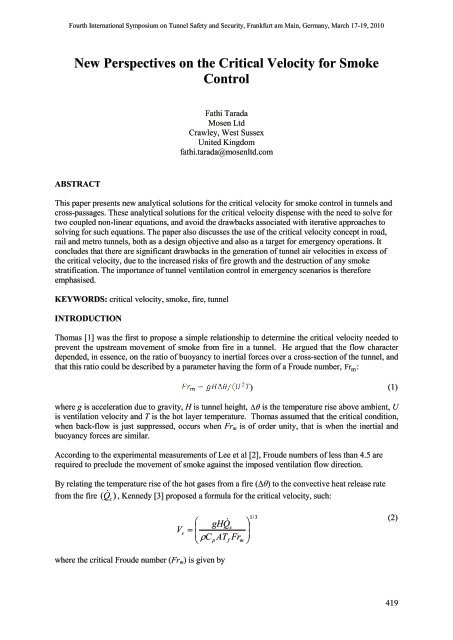
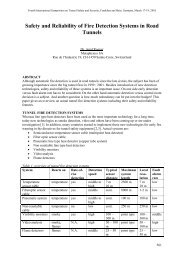
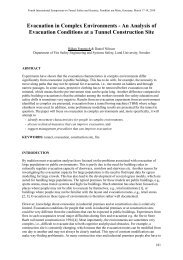

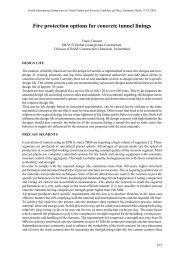
![30-37 TunnelsREV[1]rev.qxd - Industrial Fire Journal](https://img.yumpu.com/22237435/1/184x260/30-37-tunnelsrev1revqxd-industrial-fire-journal.jpg?quality=85)
